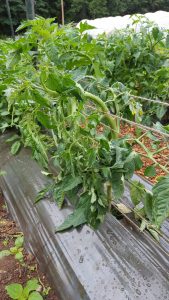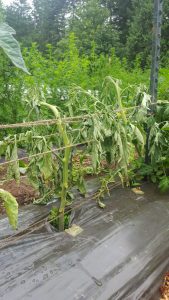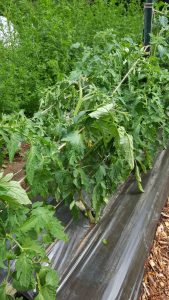With every passing week I become more and more attached to the plants that I care for. I find myself thinking about their well being and wondering if the rainy days are too wet and humid, or if the heat of summer is too hot; I have allowed myself to become connected to each one of these plants. — Groucho Marx says: “Outside of a dog, a book can be a man’s best friend. Inside of a dog, it’s too dark to read.” — All of this is on my mind because we had our first fatalities of the tomato trial. I am sad (yet oddly excited) to inform you that two of the plants have succumbed to a disease that I am in the process of identifying. I have been observing the two plants in question (Pilu KS, plot 1) over the last 3 weeks, watching them slowly lose their structural integrity while showing no signs of leaf discoloration. While, the lack of turgor pressure is only a symptom of an unknown disease, I have researched some of the possible diseases that could have caused this full-plant wilt. There is a bacterial pathogen that enters the plant through the roots, eventually clogging the vascular system, halting the flow of water and nutrients to the rest of the plant. This pathogen is known as Bacterial Wilt (Pseudomonas solanacearum) and can be soil borne or transmitted by a few different insect vectors.
It is important to note that this diagnosis is only speculation. To ensure that I get the definitive culprit I have sent a specimen (an entire plant) into the plant pathology lab at Washington State University where I will get results within a month that will include a wide array of information about exactly what was found on/in the plant. In the mean time there are some in-home tests that I can perform to either confirm or deny that it is a bacterial pathogen, information on that can be found here.
Seeing as I still have some seedings of each variety in a flat in the green house, I considered replacing the plants that were removed but decided that it would skew the plant-yield results while adding another variable to the project. While a farmer for profit would plant the back-ups and be happy with any future yield, I am more concerned with comprehensive data. It is for these reasons that I will continue the project with only 6 Pilu KS plants, instead of 8.
I am slightly perplexed as to why these two individuals were ‘attacked’ while the surrounding plants, including plants from the same variety, look happy and healthy. To further my confusion, I observed one other plant (of a different variety) showing the early signs of this full plant wilt, yet this plant (Crimson Sprinter, plot 2) is separated by about 30 row feet of healthy tomatoes. This leads me to believe that an insect carrier could be responsible for this distribution pattern. Answers to these questions will have to wait until we find out exactly what killed the plants.
Aside from dealing with the afflicted plants, I took the observational leaf curl assessments for each individual and then proceeded to prune the plants that have began to get overcrowded. In hopes of opening up space for air flow I did a bit of light pruning to the lower branches and at the same time, removing any leaves that showed signs fungal pressure. The weather for the entire last week was rather dismal (and the forecast to come doesn’t look to be much better), heavy rains and high humidity have me concerned that the spread of fungal diseases will only get worse for the time being. This weather is a good reminder of why tomatoes don’t always thrive in our region.
I have continued to observe what I believe to be Early blight on some of the older leaves of various plants throughout the tomato bed. As is expected, these leaves are removed from the plant and field to slow the spread of spores. *Note has been taken of which varieties have shown signs of fungal pressure. Along with Early Blight, I continue to see small populations of aphids on various plants, sometimes as few as one or two on an entire plant, rarely do I see any eggs or young aphids. This past week I went out with a backpack sprayer, filled with nothing but water, and proceeded to spray and aphids I saw off of the plant. With a slight amount of water pressure, the aphids are washed off of the plant and usually die before making it back onto the plant. (Aphid eggs are harder to remove and it may be easier to simply remove the leaf/leaflet that they inhabit.)
To close the week with some good news: the tomatoes have began setting fruit, or at least there are a few varieties that have a few tiny, green pearls hidden in their foliage. I can almost taste them! We will see how this coming week of rain and humidity will affect the plants.
Happy Growing!




Leave a Reply